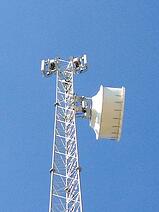LTE (Long Term Evolution) is a wireless communication standard originally developed to provide high-speed data for mobile phones and data terminals. LTE expands on 4G wireless high-speed point to multipoint wireless communications. LTE offers mobile telecommunication providers the ability to increase broadband wireless backhaul and allow for future expansion. The LTE specification provides downlink peak rates of 300 Mbit/s, uplink peak rates of 75 Mbit/s

LTE as a technology is primarily for the mobile providers and operates in licensed 700/800 MHz and 1700/1900 MHz in the United States. Other frequencies can be used internationally. LTE is typically not a wireless communication solution for enterprise and commercial end users. Other technologies, such as WiMax, point to point wireless, and point to multipoint wireless Ethernet bridges are readily available to non-mobile operates for their wireless communication needs. Although, there has been an increased opportunity for LTE for other non-mobile applications such as, Smart Grid and SCADA applications for water, gas, and electrical utilities. In this case LTE is used for both mobility and fixed wireless applications.
Utilities have the opportunity to acquire licensed wireless frequencies from the FCC and third party owners of spectrum (typically in the 700MHz bands). LTE can provide coverage areas in a macro cell of greater than 20+ miles. Ideal wireless communication coverage areas can be up to 11 miles with good coverage. LTE sites are typically on communication towers that are spaced out geographically. These sites can be connected either via fiber or by using point to point wireless bridges, like licensed microwave backhaul. To avoid wireless interference it is recommended that point to point wireless backhaul be done with licensed wireless bridges and not unlicensed wireless point to point bridges. Wireless point to point links can provide up to GigE full duplex capacity.
Because of the ability to use lower frequency bands LTE offers great coverage areas. It also protects an organzations investment by allowing for future upgrades and changes. WiMax also offeres similar coverage capability and wireless backhaul bandwidth. Both technologies offer great solutions for wireless backhaul for both mobile and fixed wireless communication applications. Even though it is truly a wireless communication standard derived for use by mobile phone porivders, other applications needing wireless broadband connectivity can benifit for the emerging tehnology.





